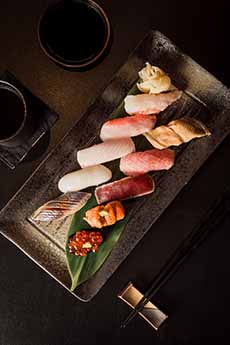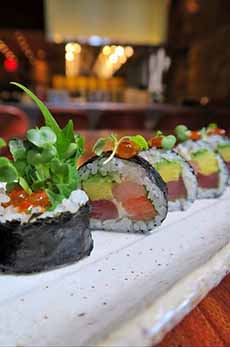FOOD 101: Sushi Etiquette
|
How do you eat sushi? Most people simply pick up the sushi with chopsticks and dip the bottom of the rice into soy sauce. But many Americans don’t know that there is actually a “proper” way to eat sushi. This example is on the “improper” list. Sushi comes with its own set of table manners. Even if you are at a casual sushi eatery in the U.S. and don’t want to mind your manners, you’ll need to learn them before a eating sushi in Japan. Here are some basics from Ken Sato, the sushi chef and director of restaurants for True World Foods, the leading distributor in fresh fish in the U.S. Yes, you can eat sushi with your hands, although—as with chicken drumsticks—not at a fine restaurant. Sushi was originally a food for gamblers, so they didn’t have to stop playing cards in order to eat. Then, it was a street food, which people ate with their hands. That’s why, at a restaurant, you receive a damp towel to clean your hands before eating sushi. No, you should not pass food to another person with your chopsticks. It’s considered rude. Put the food on a plate and pass the plate instead. Reverse the chopsticks to use the clean end (the larger end) when moving food, or when taking from a communal plate. But it is considered more refined to ask for a clean set of chopsticks to transfer food. In the case of nigiri, you don’t want the soy sauce to touch the rice. The reason is that sushi rice is already reasoned with sweetened vinegar. Instead, grasp the nigiri with chopsticks and turn it upside down. Lightly dip the fish side into the soy sauce. With a sushi roll, also dip the piece lightly. You don’t want the salty soy sauce to take away from the delicate flavor of the fish. With gunkan maki (the oval shape used to serve ikura [salmon roe] and uni [sea urchin), you cannot turn the piece upside down to dip it or the contents will fall out. So while Americans tend to dip the seasoned rice side (the bottom) into the soy sauce, Japanese would dip a piece of ginger in soy sauce and brush it over the top of the seafood. Using a lot of soy sauce is rude to the sushi chef. It’s a sign that the chef is not serving the freshest fish. The wasabi can be placed directly on the fish or it can be mixed into the soy sauce. Wasabi and ginger were originally used to help the stomach fight off potential bacteria, in the age before refrigeration. In the modern era of food safety, they have become flavor enhancers and palate cleansers. Place the pointed ends of chopsticks on a chopstick rest when the chopsticks are not being used. If a rest is not provided, make a chopstick rest by folding the paper case that the chopsticks came in. Americans rest the chopsticks on the plate or the soy sauce dish, which is fine. The tips should be pointing to the left. Do not place chopsticks on the tabletop, cross them on a plate, or vertically stick them into a bowl of rice. |
|
|
|
Here’s everything you need to know, in our Sushi & Sashimi Glossary.
|
||






